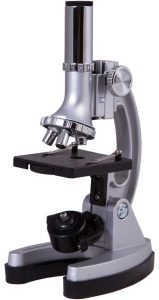In the development of science, a special role was played by two devices that dramatically expanded the limits of knowledge - a microscope and a telescope. If in ancient times a person could perceive the world only on a scale comparable to the size of his own body, then the microscope spoke about the existence and amazing properties of the smallest particles of matter and tiny living organisms, and allowed him to take the first step into the microworld. The telescope brought distant stars closer, forcing mankind to realize its place in the Universe, opened the megaworld to our gaze. The microscope and telescope (more precisely, the telescope) appeared almost simultaneously, at the end of the 16th century, but the microscope quickly went from the first primitive models to a full-fledged optical device.
 The invention of these devices is associated with the name of the Dutch master Zachariah Jansen, who proposed in 1590 a scheme for a telescope and a microscope. Then, the improvement of both devices was done by Galileo and Kepler. In 1665, the English scientist R. Hook, using a microscope, discovered the cellular structure of all animals and plants, and ten years later, the Dutch natural scientist A. Levenguk discovered microorganisms.
The invention of these devices is associated with the name of the Dutch master Zachariah Jansen, who proposed in 1590 a scheme for a telescope and a microscope. Then, the improvement of both devices was done by Galileo and Kepler. In 1665, the English scientist R. Hook, using a microscope, discovered the cellular structure of all animals and plants, and ten years later, the Dutch natural scientist A. Levenguk discovered microorganisms.
After 200 years, the German physicist Abbe, an employee and partner of K. Zeiss, the owner of the famous optical workshops, developed the theory of the microscope and created its modern version, the possibilities of which are limited not by design flaws, but by the fundamental laws of physics. The human eye can discern a detail the size of a tenth of a millimeter. An optical microscope can magnify it a thousand times. Complicating the lens system would not be difficult to achieve a larger magnification, but this would not make the image clearer. The fact is that matter simultaneously possesses both wave and corpuscular properties. This applies to light, and its wave properties do not allow you to see objects whose dimensions are less than tenths of a micron.
Diffraction is characteristic of waves — they bend around obstacles the size of which is small compared to the wavelength. For example, a straw sticking out of the water does not prevent ripples from spreading, while a large stone holds it back. To be able to notice an object, it must delay or reflect light waves. The wavelength of light visible to the human eye is measured in tenths of a micron. This means that smaller parts will have almost no effect on the propagation of light, and therefore no optical device will help to detect them.
 However, wave-particle duality not only limits the increase in conventional microscopes, but also opens up new possibilities for studying matter. Thanks to it, you can get an image not only with the help of what we are accustomed to consider waves (visible light, x-rays), but also with the help of what we consider to be particles (electrons, neutrons). Therefore, microscopes have now been created, showing objects not only in ordinary light, in ultraviolet or infrared rays, but also electron and ion microscopes, the magnification of which is a thousand times greater than that of optical ones. X-ray and neutron microscopes are developed. The advantage of new devices is not only a larger increase, but also the variety of information that they provide. For example, infrared microscopes make it possible to study opaque crystals and minerals, ultraviolet ones are indispensable in forensic science and biological research, X-ray ones would be able to shine through very thick samples without destruction, and neutron ones could distinguish details consisting of different chemical elements. The improvement of the microscope continues, and this device will still serve science.
However, wave-particle duality not only limits the increase in conventional microscopes, but also opens up new possibilities for studying matter. Thanks to it, you can get an image not only with the help of what we are accustomed to consider waves (visible light, x-rays), but also with the help of what we consider to be particles (electrons, neutrons). Therefore, microscopes have now been created, showing objects not only in ordinary light, in ultraviolet or infrared rays, but also electron and ion microscopes, the magnification of which is a thousand times greater than that of optical ones. X-ray and neutron microscopes are developed. The advantage of new devices is not only a larger increase, but also the variety of information that they provide. For example, infrared microscopes make it possible to study opaque crystals and minerals, ultraviolet ones are indispensable in forensic science and biological research, X-ray ones would be able to shine through very thick samples without destruction, and neutron ones could distinguish details consisting of different chemical elements. The improvement of the microscope continues, and this device will still serve science.



